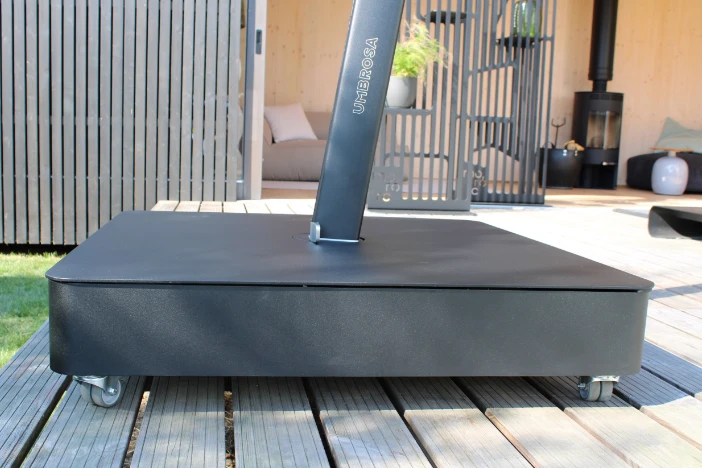
Stability is non-negotiable for outdoor umbrellas
Okay, you’ve determined the perfect type, size and shape of umbrella for your outdoor space – congrats! You can take a breath but the work’s not over. It’s time to figure out the patio umbrella base or mount to keep it secure. Your umbrella should remain upright under calm conditions and not fly away when there’s a gentle breeze. Center pole and cantilever umbrellas can use freestanding bases or fixed mounts. The latter is more appropriate for larger umbrellas and windier settings.
Freestanding bases (a.k.a. mobile)
Freestanding bases are what most people think of when they picture residential shade umbrella stands. Even though they are heavy, these stands can be moved from one spot to another with minimal difficulty. Some have wheels, casters or handles to make relocating easier. Otherwise, you may need to detach the umbrella from the base before moving the latter to a new position. Most freestanding bases are round, square or rectangular.

Even though they serve a common purpose, bases come in many designs. They use different methods and materials to provide the weight needed for stability. Most fall into one of three types of base structure.
- Solid – These sturdy bases are typically constructed using solid iron or steel plates, concrete or stone slabs
- Framed – Many strong versions have steel frames. Some have powder-coated aluminum covers. You can stack concrete or steel pavers or other heavy materials in them
- Fillable – Hollow plastic ones are filled with sand or water to create the weightiness
If you have an outdoor table with a market umbrella hole, measure your mobile base to ensure it safely fits below. Account for leg room as well as the legs and framework of the table.
Do you want your umbrella and base to blend seamlessly with your outdoor decor and architecture? If so, the type and style of base will matter a great deal.

Solid parasol bases
Solid bases tend to have a clean minimalist look, unless they are constructed using molded metal or wrought iron. These ornate metal stands are often used in traditional settings in concert with complementary furnishings. However, even simple designs can vary greatly in their appeal. For example, a thin steel plate base with rounded corners has a sleek low-profile perfect for modern exteriors. That is a much different look than a thick, square block of granite. Some metal versions allow you to stack multiple plates to increase the weight. This can be handy if you’re on the coast or in a windy environment and need additional ballast.
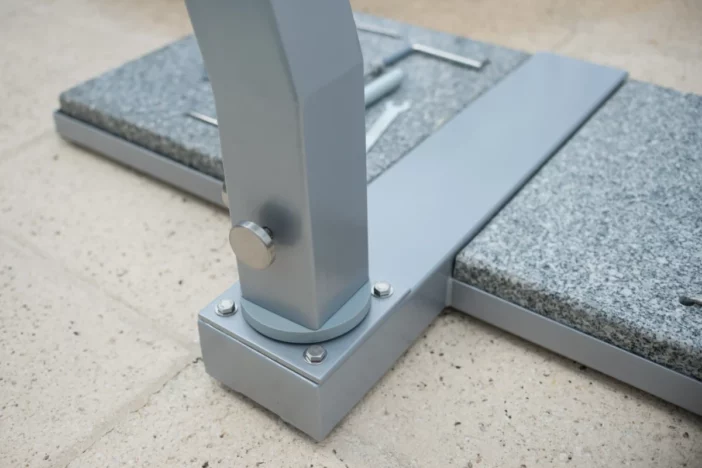
Framed outdoor umbrella bases
Framed bases are typically made of stainless or galvanized steel, or aluminum (smaller sizes). The framework is designed to hold heavy metal plates or pavers (flat stone, brick or concrete slabs), which stabilize an umbrella. In many instances, pavers are not included with framed bases and must be purchased at a local home supply or hardware store. This is especially true when ordering online. Shipping costs are higher the heavier the item. So, it’s less expensive to pick up pavers locally than pay a freight company. Stone and concrete paves are readily available and relatively inexpensive. One problem with some European framed models is that standard American pavers may need to be trimmed to fit. While not ideal, it’s usually pretty easy to chip away a little at the corners until they slide in place.
Large frame parasol bases may have aluminum covers, while others are left with the pavers exposed. Covered models often have powder-coated finishes in popular neutral tones. This helps protect the metal from corrosion and gives you a chance to match your umbrella and furniture. Small models may have molded plastic or ceramic covers with decorative surfaces and a variety of color options. Uncovered versions have an industrial look. They may require periodic attention to ensure debris and moisture don’t accumulate in crevices.
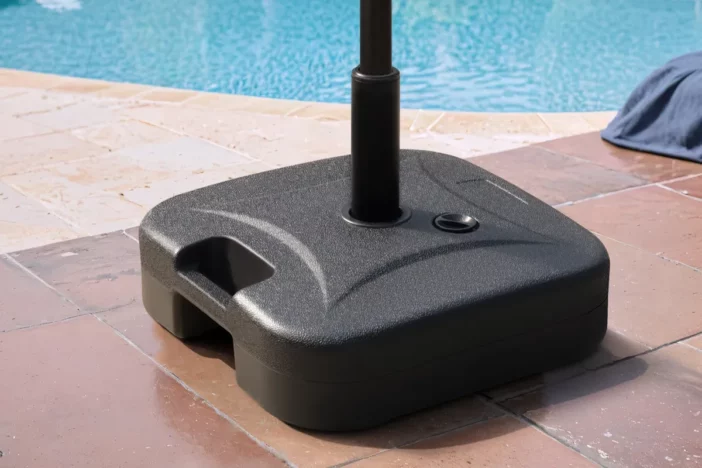
Fillable mobile bases
Fillable patio umbrella bases are popular with those on a tight budget. The hardened plastic shell bases are usually significantly less expensive than metal or mineral alternatives. This is due to the lower cost of the plastic itself as well as the material that fills them. They often have rounded edges, which makes them safe for children or high-traffic areas. They have one capped opening on the top for pouring in water or sand. There is usually a second opening near the bottom for draining. This makes it very easy to lighten them when moving or storing the umbrella. Water should be changed periodically to prevent bacteria build-up. Mass merchandisers frequently carry filled bases for their umbrellas but tend to offer only one or two colors.
How heavy does the deck umbrella base need to be?
The weight required for your mobile base depends on three factors:
- Size of your umbrella canopy
- Expected environmental conditions
- Presence or absence of an umbrella table
There are many schools of thought as to how much weight is needed but we tend to err on the side of safety. To account for average wind conditions, we recommend using 10 pounds for every foot of the canopy. This applies to free-standing center pole umbrellas. If the pole runs through an umbrella table, you can reduce it to 5 pounds per foot.
The best offset umbrellas come with a mobile base or offer fixed mount options. This makes it easier to choose. However, bases for cantilever umbrellas often run 30-40 pounds per canopy foot or more. They also tend to be much larger, requiring a lot of room to the side of a dining table or lounge seating area.
Recommended deck umbrella minimum base weights*
| Type / Size | 7′ | 8′ | 9′ | 10′ | 11′ + |
|---|---|---|---|---|---|
| Market Umbrella | |||||
| (Through table) | 35 lbs | 40 lbs | 45 lbs | 50 lbs | 55 lbs |
| (Freestanding) | 70 lbs | 80 lbs | 90 lbs | 100 lbs | 110 lbs |
| Cantilever Umbrella | 210 lbs | 240 lbs | 270 lbs | 300 lbs | 330 lbs |
*These are general guidelines. Follow the umbrella manufacturer’s recommendations for their specific models.

Permanent mounts (a.k.a. fixed)
A fixed mount is commonly used for larger umbrellas, when the environment is windy or it’s a commercial installation. As the name indicates, fixed mounts are not portable. They are secured to a single location by means of an attachment kit that varies by surface type. In practice, fixed mounting kits are the best choice to guarantee the stability of your umbrella. Commercial environments are extremely active and the decor takes a regular beating. So, fixed mounts are frequently used at restaurants, bars and resorts.

However, permanent mounts are only as stable as the surface or surrounding area. It’s critical to evaluate the strength and durability of the floor, wall or ground before installing a mount. Umbrella manufacturers typically include substrate recommendations or minimum requirement for safe use in their installation manuals. You may also have to purchase additional bolts and screws of varying lengths depending on your mounting surface. It’s a good idea to talk to an expert or check with manufacturers. Don’t assume you have the right securing hardware out of the box.
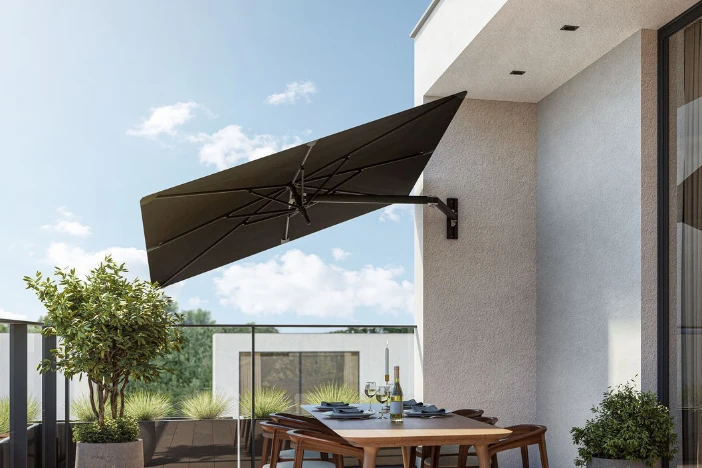
There are three categories of fixed mounts:
- Floor Mount – This is the most popular fixed base structure. Floor mounting kits enable you to quickly secure a base plate and sleeve to a concrete patio, hardwood deck or cement poolside. They work great beneath all kinds of umbrella tables since you don’t need clearance for a bulky stand.
- Wall Mount – This can only be used for offset umbrellas specifically designed to accommodate vertical mounting. Consider a wall mount when you have a small area, where ground space is at a premium.
- In-Ground – These bases are inserted directly into the ground and can be secured by pouring concrete around them. If you have soft dirt or loose gravel and want to establish a permanent setting, this type might not be the best choice.
Base tube diameter
Whether you’re using a mobile or fixed base, make sure that it can accommodate the diameter of the umbrella pole. Most center pole umbrellas range from 1 1/2 to 2 1/2 inches in diameter. If purchasing the umbrella and base from different sources, please double-check with the manufacturers to ensure compatibility. Ideally, you want a base tube no more than 1/4″ wider than the umbrella pole to ensure a snug fit.
Helpful base and mount reference
Here’s a great resource from Woodline to better understand many types of bases and mounts.
Completing the essentials checklist
At this point, you’ve got a good idea of what to look for to shade your outdoor setting. In the next section, we look at some additional features and accessories that can enhance your umbrella’s capabilities.




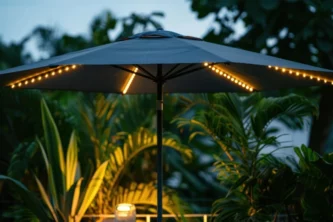
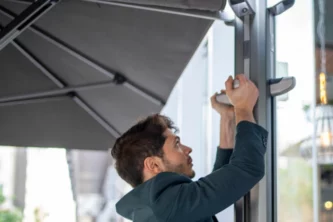





Leave a Reply